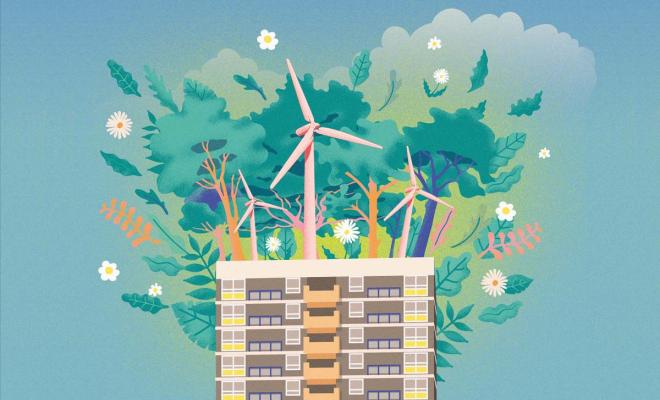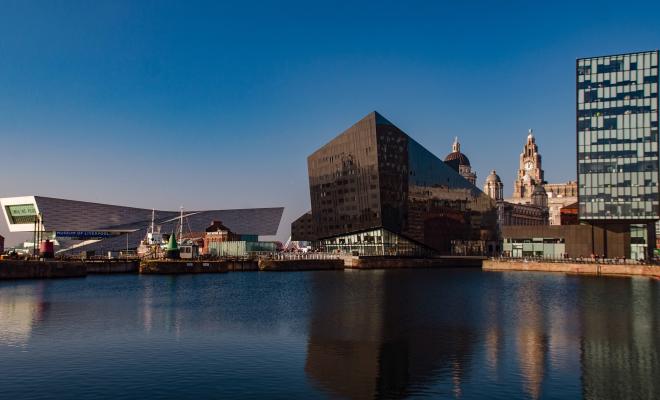12 Apr 2023
How is Action 31 tackling the climate crisis?
Generating electricity is responsible for 23% of UK greenhouse gases. Councils have a key role to play by generating their own renewable electricity on buildings and land assets, ensuring energy is not wasted and supporting the switch to renewable energy sources across their own operations.
Cambridgeshire County Council is aiming to make all the buildings it owns and operates fossil fuel-free by 2025. It's doing this through a range of opportunities, including developing its ambitious solar energy projects.
The council won the pioneer category at the British Renewable Energy Awards in 2018 for setting up a successful solar farm and it's now launching a host of others. Solar farms that would deliver surplus energy (and therefore revenue) are prioritised to strengthen the council’s finances. This approach has been incorporated into the council’s six priorities for renewable energy, outlined in its Corporate Energy Strategy, which guides all energy projects in the county, including those on the council’s own estate. They are:
- creating low carbon energy
- local generation and supply
- energy efficiency
- managing cost (via negotiating contracts and collective purchasing)
- generating income
- supporting sustainable growth.
Triangle Solar Farm: a successful pilot
The Triangle Solar Farm in Soham was an early pilot case for Cambridgeshire and has since become the council’s flagship project fulfilling all six of the above criteria. Construction of the 45,000 panel, 70-acre solar farm began in 2016 and it went live in January 2017. This 12 megawatt (MW) solar farm produces enough energy to power 3,000 homes.
Triangle Farm was built on the basis of a 25-year life span, over which it will provide an income to the council. This has benefitted communities through support for the council’s frontline services.
Triangle was the springboard for Cambridgeshire to expand its vision. New solar projects in the pipeline total 42 MW and will focus on making the most of the council’s assets at park and ride sites, disused landfill sites and across its rural estate.
What impact has the project had?
Triangle Solar Farm
In the first year of operation, it over-performed on expected electricity generation by 5%, raising £50,000 above projected income per annum. The farm, after debt charges on its capital borrowing, currently raises a net £350,000 revenue a year for the council. Once the original loan used to finance the farm is paid off, revenue will increase to £1 million.
This income prevents the council from having to make bigger cuts than it needs to. The money has been used to part-fund adult social care services, including buying equipment and technology to support elderly people living independently. It's also been channelled into services for those living with a physical disability or sensory impairment, as well as protection for adults vulnerable to abuse or neglect.
Over its 25-year lifetime, the Triangle Solar Farm will save 135,170 tonnes of CO2 emissions. In the year 2018/19 it saved 3,758 tonnes. Every year, Triangle Farm is saving emissions equal to removing 695 cars from the road.
New solar farms and battery storage
On the back of the achievements with Triangle Farm, new projects have been rolled out across the county. These will contribute to a local green recovery from the coronavirus pandemic.
North Angle Solar Farm. Work started in 2021 on this 180-acre solar farm with 39 MW capacity. It will generate enough electricity to power 12,000 homes, saving 90,000 tonnes of CO2 emissions over the 25-year project lifetime. Biodiversity will be enhanced by a community green space, planting of species-rich grassland and fruit trees, and over two kilometres of new hedging and woodland to help screen the solar farm.
Babraham Park and Ride is a smart energy scheme to redevelop a park and ride site in Great Shelford Parish. The planned 2.5 MW solar carport would include battery storage and electric vehicle charge points. The park and ride could generate enough electricity to power 700 homes and would potentially save 6,400 tonnes of CO2.
St Ives Park and Ride is a smart energy grid demonstrator project on a park and ride site which will comprise solar panels installed in canopies over car parking spaces, battery storage and electric vehicle charging infrastructure. 1 MW of renewable energy generated from the solar panels will power the park and ride, as well as provide energy to two local businesses via private wire connections.
Swaffham Prior Community Network. In 2017, the council in partnership with Swaffham Prior Community Land Trust initiated a project to bring cheaper, renewable heat to as many homes as possible in the village. Swaffham Prior will become one of the first villages in the UK to retrofit a heating network into an existing community.
Stanground Solar Farm is a 2.9 MW solar farm with a battery storage system on a former landfill site, which is now closed and capped. Planning approval was received in January 2021 and options for the project are now under review.
Powering the new council offices
The council’s new headquarters at Alconbury Weald will be partly powered by an on-site solar carport. The carport will help meet approximately 40% of the building’s electricity demand and provide clean energy for electric vehicle charge points. This will amount to a reduction of 720 tonnes of CO2 emissions at the new premises, named New Shire Hall.
These measures are a result of the near zero energy building standards put in place by the council in 2019. When a new asset is purchased or built by the council, like its new headquarters or a care home, standards of 80% on-site renewable energy and high efficiency for the building fabric must be met.
What made this work?
Local assets
Cambridgeshire County Council made the most of local resources: world-renowned academic research at Cambridge University and Anglia Ruskin University and a growing clean technology sector, one of the largest in the UK. The combination of research and industrial assets provides the council with valuable resources to draw on, expanding innovation in its own projects.
Long-term capacity building
The council began its journey in 2013 when it received a grant from Intelligent Energy Europe. The grant helped lay the groundwork by identifying a framework for the council’s energy infrastructure investments. Staff were upskilled and taught about business models, establishing supply chains, and the risks and issues associated with implementing large energy projects. Cambridgeshire’s efforts to improve its in-house capacity have been consistent and prolonged.
Knowledgeable council officers
The council now has an expert renewables team with a detailed knowledge and skill base. Having a highly competent financial modeller is particularly important – someone with credibility who understands accounting, project finance and the ins-and-outs of the energy market.
Reliable contractors
Bouygues E&S Solutions Limited has been the council’s go-to partner for energy infrastructure since 2014, which has brought consistency across its projects. The firm has experience specifically in designing projects that help local authorities cut energy bills.
Replicability
Developing the pilot project at Triangle Farm gave Cambridgeshire a tried and tested model that could easily be applied to other similar council assets.
What resources were needed?
Since 2015, Cambridgeshire County Council has invested over £22 million into energy generation to improve the efficiency of council properties. In February 2020, the council approved new funding of £16 million to reduce carbon emissions across the council portfolio even further.
£10 million was invested into Triangle Solar Farm through a loan from the Public Works Loan Board. Alongside this, the council also made a successful bid to the (now dissolved) Department of Energy and Climate Change, via its Contracts for Difference renewable auction. This guaranteed a price for electricity generated at Triangle and sold on the wholesale market.
The council is investing £26 million in North Angle Solar Farm and the Babraham Park and Ride Scheme is set to cost £7.4 million.
Historically, the council has received money via the European Regional Development Fund, and it continues to borrow frequently from the Public Works Loan Board to make sizeable investments and cover the upfront costs of projects. Large solar projects like Cambridgeshire’s cost more upfront, but bring significant operational savings and income compared to smaller schemes.
Most of the council’s projects generate revenue through the sale of electricity to the National Grid. However, the council is also exploring options for raising revenue through private wire connections. The business model used varies from project to project depending on each one’s scale and attributes.
To oversee the delivery of its numerous projects, the council created the Energy Investment Unit. Prior to this, there was no organising structure in Cambridgeshire that could properly deliver these projects. The ten staff members in this unit work closely with colleagues in the finance, rural estate and legal teams.
Lessons from Cambridge
Anticipate changes in the energy market
The Cambridgeshire team faced difficulties during the early stages of the COVID-19 pandemic due to plummeting prices of oil and gas. Although this was only a short-term trend, it disrupted the development of project business cases at the time. Being flexible and anticipating surprise changes is crucial when overseeing renewable energy ventures because the market is always rapidly evolving.
Stagger new projects
The council also struggled with having multiple projects in the pipeline coming to fruition simultaneously. This caused a spike in workload, meaning the team had to manage numerous projects with too few resources. Other councils can learn from this by staggering their projects.
Engage council officers widely
A very important lesson is ensuring council officers are willing to take others on their journey. At Cambridgeshire, the Energy Investment Unit worked on the edges of the council to build up its own expertise but recognised that to move at scale this knowledge needed to be transmitted to a wider set of people within the authority.
Cambridgeshire has witnessed a change in councillors’ appetite for risk precisely because officers have worked closely with politicians to build up their understanding of how projects work. In turn, councillors feel more comfortable with the risks being taken, giving them the political courage needed to make big decisions.
Finding the right sites
Cambridgeshire County Council manages a significant amount of agricultural land, giving it multiple site options for solar projects. Other councils, especially urban ones, will be more pushed for space, and more likely to focus on installing solar on buildings, though brownfield sites can be suitable for solar projects in urban areas.
Both the Triangle and North Angle solar farms were built on sites with the right characteristics: flat, relatively remote rural locations with space away from residential properties, close to grid connection options. Both farms were also built on agricultural land of average quality, as opposed to high quality land which would be better used for crop growing.
A lesson from the early development stage of the Stanground project is that support for renewable projects is increasing, even if they are in close proximity to residential properties. The Stanground Project got 9 votes in favour (with 1 abstention) at the Peterborough Planning Committee meeting.
Sources of funding
The volatility of government policy means that large solar projects are no longer eligible under the Contracts for Difference scheme, nor is the government’s Feed-in Tariff scheme available after it closed to new entries in March 2019. In addition, the government has been gradually tightening restrictions on how funds from the Public Works Loan Board can be spent to prevent local authorities from making imprudent financial decisions.
However, due to economies of scale and a steep drop in set up costs and prices for solar panels, councils should be able to construct a viable business model even without government support. Cambridgeshire now operates on a "no subsidy" business model. The size of projects has increased so that economies of scale will enable them to work subsidy-free. The UK Infrastructure Bank may become a source of investment for subsidy-free solar in the future.
Sheryl French, Assistant Director of Climate Change and Energy Services at Cambridgeshire County Council.
Clare Julian, Energy Manager at Cambridgeshire County Council.
Useful information
To contact Cambridgeshire County Council for more information, contact Sheryl French or Sandra Bucci.
Read Energy Hub’s case study on Cambridgeshire.
Read the Corporate Energy Strategy for the Cambridgeshire and Peterborough Combined Authority.
Related projects
We've found some examples of other council activity on this topic.
- Manchester City Council is taking measures to cut energy use and install renewables across 13 of its buildings.
- Lancaster City Council has completed the decarbonisation of its Salt Ayre Leisure Centre.
- Salford City Council is installing solar panels and heat pumps to decarbonise its buildings.
Friends of the Earth's view
Tackling emissions from their own operations is a must for all councils including cutting energy use and increasing renewable energy generation. Cambridgeshire County Council is making great strides to ensure more solar power for council buildings and private homes, and showing how it's possible to raise money from investing in renewables.
Councils should also identify suitable areas for renewables – including onshore wind – in their Local Plans (Action 29 of the Climate Action Plan for Councils).
Friends of the Earth is showcasing specific examples of good practice in tackling climate change, but that doesn’t mean we endorse everything that a council is doing.
This case study was produced by Ashden and Friends of the Earth.





